Abstract
An on farm trial (OFT) was conducted during Covid 19 crisis on improved variety of SVVU T17 pigs where a total of 64 pigs were distributed to rural farmers in Guntur district to improve their livelihood in the year 2020. In the present study SVVU T17 pigs achieved an average body weight of 70 – 75 kgs at 8 months of age. The average pork production was 60 kgs per pig and with a litter size of 8 – 12 piglets. The result revealed a significant increase in income @ 1,56,800/- per family per annum by sale of pigs and pork and also a significant increase in consumption of pork among below poverty line (BPL) families. Moreover, rearing SVVU T17 pigs enhanced the confidence levels of poor farmers, weaker sections of society and rural women by generating income source for themselves.
Key words: Rural Women, SVVU T17 Pig, Livelihood, Rural Farmers
Introduction
Pig farming is an age old practice in rural India. Much of the pig farming comprises of rearing indigenous pigs with poor production performance. The productivity of indigenous pigs in terms of meat production is only 35–40 kgs per pig and litter size is also very less i.e. 4-6. However pig production can easily be boosted up with improved varieties of pigs and can promise a better production of pork. The crossbred pig variety SVVU T17 was developed by AICRP on pigs of Sri Venkateswara Veterinary University (SVVU), Tirupati. The variety was developed by crossing of Large White Yorkshire with Desi pig of the state with 75% exotic inheritance. Rearing of SVVU T17 pigs is an important source of livelihood for rural people of Andhra Pradesh. The most preferred quality pork is obtained from SVVU T17 pigs, which is sold at a premium market price. Rearing of pigs has improved food security and the economic status of BPL families in Southern India. The measurement of socioeconomic status (SES) in the population provides important information for the analysis of in equality and poverty, based on which economic and public health policies and interventions are planned and implemented (Kattula et al., 2016). The growing demand for pig meat products and low investment in pig sector provides opportunity for the rural farmers and women to have supplementary income generation for the family. However, the problems of low weight gain, less number of piglets per litter with Desi pigs are some of the hindrances in pig production which need to be overcome through introduction of improved variety of pigs with better performance levels. In order to improve the livelihoods and nutritional security of BPL families through pig farming Sri Venkateswara Veterinary University (SVVU), Tirupati, has developed a crossbred variety, named SVVU T17. Hence, the present study was undertaken to determine the performance of SVVU T17 pigs and its impact on the livelihood and nutritional security of BPL families in rural areas of Guntur district in Andhra Pradesh.
Materials and Methods
SVVU T17 pigs were reared in sheds made of concrete flooring system at Krishi Vignan Kendra, Sri Venkateswara Veterinary University, Lam, Guntur upto the age of 1 year on balanced diet as per the recommended protocol. A total of 64 pigs were distributed to four beneficiaries belonging from BPL families of rural areas of Guntur district at different intervals at the rate of 16 each. Each unit comprised of two males, ten females and 4 piglets. Before distribution a training programme was organized to educate the farmers on management and disease prevention in pigs. The study was carried out from January 2020 to January 2021 and data on production performance of pigs was collected from the beneficiaries through semi structured interview schedule and the data was statistically analysed (Snedecor and Cochran, 1994).
Pigs at Krishi Vignan Kendra, Lam , Guntur

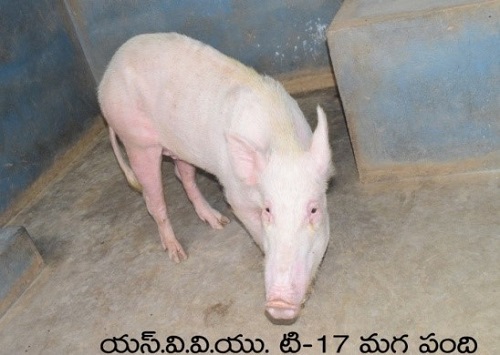
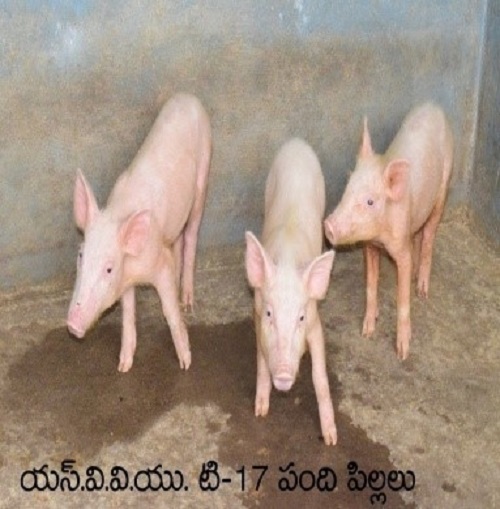
Results and Discussion
Body weight at different ages
Perusal of Table 1 revealed that majority of the beneficiaries (50%) observed the body weight of 1.5 kgs at birth. The present finding is in agreement with Prasad et al (2006) and Palve et al (2000) who reported an average birth weight of 1.20± 0.03 and1.27±0.04 kgs, respectively in Large White Yorkshire piglets. Peterson (2008) showed that increase in birth weights up to 1.5 kg were accompanied by increasing growth rates; above that weight there was no effect of birth weight on growth rates. Majority of the beneficiaries (50%) observed the body weight of 10 kgs at weaning. Nath et al (2002) observed that the higher weaning weight 13.98±0.25 kgs was recorded at weaning in their studies. Kalita et al (2001) reported a higher weaning weight which might be due to smaller litter size at birth (7.11±1.03) and availability of more milk from the mother. Majority of the beneficiaries (50%) observed the body weight of 75 kgs at 8 months age. The optimum body weight in the present study might be attributed to better feeding practices adopted in the farm. SVVU T17 was known for its better feed conversion efficiency (Patience et al., 2015) with an average post weaning daily gain of 271 g. However it was comparable with International standards (Sastry, 1998). Kumaresan et al (2006) have shown that the average daily weight gain up to 9 months age was 185, 174 and 122 g for Hampshire, Large White Yorkshire and Mizo local pigs, respectively. In another study the average daily gain of local pigs on rural and peri-urban small holder farms in two districts of Western Kenya, the ADG was higher in peri-urban pigs (0.15±0.058 kg/day) than rural pigs (0.11±0.047 kg/day) (Carter et al., 2013).
Table 1: Production parameters of SVVU T17 Pigs.
|
S. No. |
Parameters | Number of Beneficiaries |
Percentage n= 4 |
|
1 |
Body weight at different ages | ||
|
a. |
Birth weight (kgs) | ||
| 1 | 1 | 25 | |
| 1.5 | 2 | 50 | |
| 2 | 1 | 25 | |
|
b. |
Weaning (kgs) | ||
| 10 | 2 | 50 | |
| 11 | 1 | 25 | |
| 12 | 1 | 25 | |
|
c. |
18 weeks (kgs) | ||
| 40 | 1 | 25 | |
| 45 | 2 | 50 | |
| 50 | 1 | 25 | |
|
d. |
8 months (kgs) | ||
| 60 | 1 | 25 | |
| 70 | 1 | 25 | |
| 75 | 2 | 50 | |
|
2 |
Litter size | ||
| 8 – 10 | 1 | 25 | |
| 10 – 12 | 2 | 50 | |
| >12 | 1 | 25 | |
|
3 |
Pork produced (kgs) | ||
| 55 – 60 | 1 | 25 | |
| 60 – 65 | 2 | 50 | |
| 65–70 | 1 | 25 |
Litter size
From the table 1, it was found that the litter size of SVVU T17 pigs ranged from 8 – 12 piglets with a mean of 10 piglets under intensive farming conditions. Optimum litter size in this study is due to better feeding and managemental practices being followed in the farm (Table 1). Prasad et al (2006) reported that the average litter size at birth and at weaning were 7.11±1.03 and 5.56±0.92 respectively, in large white Yorkshire pigs in Andhra Pradesh. Palve et al (2000) reported a higher litter size of 9.34±0.57 at birth and 7.84±0.54 at weaning respectively. Ramesh et al (2001) while studying the effect of housing on growth in Large White Yorkshire pigs reported lower values of 5.84±0.68 and 4.00±0.69 respectively for litter size at birth and weaning, respectively. However the litter size at birth in the present study is comparable with Srinivasa Rao et al (2000). While Quesnel et al (2008) showed that sows in poor condition at weaning and those with high body weight and fat loss during lactation have been shown to have greater embryo mortality and to produce smaller litters with greater variation in birth weight in the subsequent parity. Several studies have shown that feeding relatively high levels of arginine in late pregnancy increases numbers born and birth weights (Wu et al., 2007).
Pigs at Farmers Shed
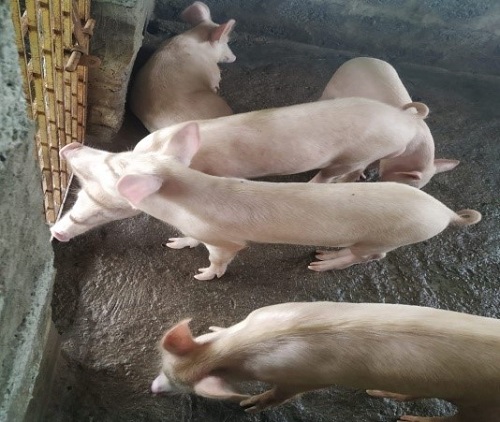
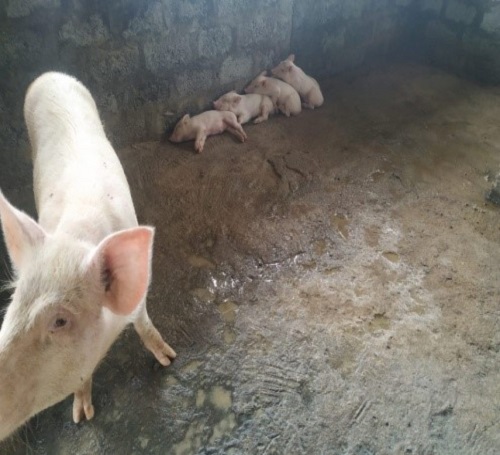
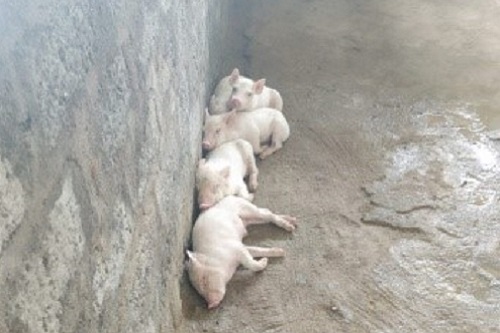
Pork production
In the present study, 50% of the beneficiaries got 60 – 65 kgs pork per pig and 25% beneficiaries got 55 – 60 kgs pork per pig during slaughter. However, few respondents reported less than 55 kgs pork (Table 1). Optimum pork production in this study is due to better feeding and managemental practices being followed in farm. The present finding is in agreement with Tomović et al (2016).
Economics
Income through sale of adult males of Rs.38,400/- and sale of pork of Rs. 38,400/- (@ 320/- per kg pork) was observed among majority of the beneficiaries (Table 2). The net profit per 16 pigs per annum was Rs.1,56,800/- and net profit per pig was 13,066/- which was felt by the farmers as an economically viable enterprise. Raja et al (2016) reported that break even analysis of Swine farming in North Eastern Tamil Nadu, India.
Table 2: Economics of SVVU T-17 Pigs
|
S.No. |
Expenditure |
Rs. |
|
1 |
Net income per annum | 3, 00, 800/- |
|
2 |
Net profit per annum | 1, 56,800/- + 264.82 |
|
3 |
Net profit per pig | 13, 066/- |
|
4 |
Initial weight | 1 – 2kg |
|
5 |
Final weight | 70 – 80kg |
The highest returns were mainly due to better sale of pork and accompanied by low mortality during the study period. The average annual consumption of pork per person increased from 4 kg per annum to 5 kg per annum. The number of pig per unit household is the best indicator to measure the impact of pig development in villages. The increased income over the rearing of SVVU T17 pig might be due to better productivity and reproductive performance than Native pigs.
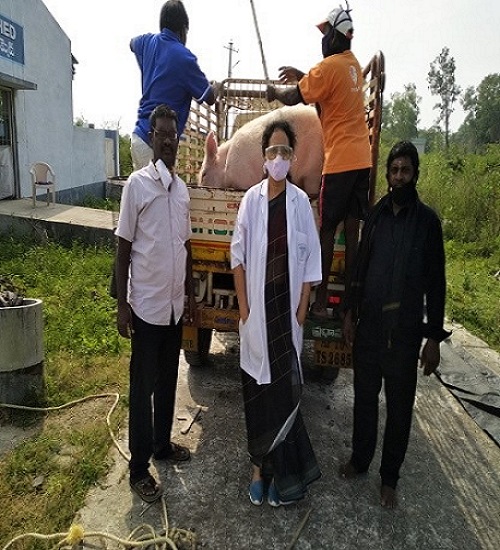
Conclusion
From the present study, it can be concluded that SVVU T17 pig performs better under scavenging conditions to uplift their economic status. A significant increase in subsidiary income (@ 3,00,800/- per family per annum) was observed. It was also noticed that there was significant increase in consumption of pork among the beneficiary families. The present study has achieved its goal by initiating income generating activity among the rural farmers and developed the entrepreneurial skills which helped in enhancing the self-esteem of rural people.
References
- Carter N, Dewey C, Mutua F, de Lange C and Grace D (2013). Average daily gain of local pigs on rural and peri-urban smallholder farms in two districts of Western Kenya. Tropical animal health and production 45(7): 1533-1538.
- Kalita D, Das D and Goswami R N (2001). Body weight of indigenous pigs of Assam and their crosses with Hampshire as affected by various factors. Indian Veterinary Journal. 78: 1024.
- Kattula D, Venugopal S, Velusamy V, Sarkar R, Jiang V, Henry A, Deosaran J D, Muliyil J and Kang G (2016). Measuring poverty in southern India: a comparison of socio-economic scales evaluated against childhood stunting. PloS one 11(8): e0160706.
- Kumaresan A, Hussain J, Ahmed S K and Pathak K A (2006). Growth performance of Hampshire, Large White Yorkshire and Mizo local pigs under field condition in Mizoram. The Indian Journal of Animal Sciences 76(2): 148 – 150.
- Nath D R, Deka D and Saika S (2002). Certain economically important reproductive traits of Hampshire, Large Black and crossbred pigs of Assam. Indian Veterinary Journal 79: 715.
- Palve S, Maitra D N, Pyne A K, Roy S K and Majumder S C (2000). Effect of season on Litter Traits of Large White Yorkshire Pigs in West Bengal. Indian Veterinary Journal 77(7): 640-642.
- Patience J F, Rossoni-Serão M C and Gutiérrez N A (2015). A review of feed efficiency in swine: biology and application. Journal of Animal Science and Biotechnology. 6(1): 1-9.
- Peterson B A (2008). Effect of birth and weaning weight on variation in growth performance parameters and carcass characteristics and composition of pigs. Ph.D. Thesis submitted to University of Illinois, Urbana-Champaign.
- Prasad R M V, Jayalakshmi P and Krishna Reddy G V (2006). Performance of Large White Yorkshire in Andhra Pradesh. The Indian Veterinary Journal 83(4): 454 – 455.
- Quesnel H, Brossard L, Valancogne A and Quiniou N (2008). Influence of some sow characteristics on within-litter variation of piglet birth weight. Animal 2(12): 1842-1849.
- Raja B, Selvakumar K N, Pandian S S, Sundaram M and Murugan J (2016). Break-Even Analysis of Swine Farming in North Eastern Tamil Nadu, India. International Journal of Science, Engineering and Technology 4(6): 823-25.
- Ramesh V, Saseendran P C and Thomas C K (2001). Effect of housing systems on the reproductive performance of gilts. Indian Veterinary Journal 78: 509.
- Sastry N S R and Thomas C K (1998). Livestock Production and Management. 3rd Edition, Kalyani Publishers, New Delhi, India, 515.
- Snedecor G W and Cochran W G (1994). Statistical Methods. 6th Edition, Oxford and IBH Publishing Co, Calcutta, India.
- Srinivasa Rao S and Yedukondala R (2000). Report on all India Coordinated Research project on pigs. College of Veterinary Science, Tirupati, Andhra Pradesh.
- Tomović V M, Šević R, Jokanović M, Šojić B, Škaljac S, Tasić T, Ikonić P, Lušnic Polak M, Polak T and Demšar L (2016). Quality traits of longissimus lumborum muscle from White Mangalica, Duroc× White Mangalica and Large White pigs reared under intensive conditions and slaughtered at 150 kg live weight: a comparative study. Archives Animal Breeding 59(3): 401-415.
- Wu G, Bazer F W, Davis T A, Jaeger L A, Johnson G A, Kim S W, Knabe D A, Meininger C J, Spencer T E and Yin Y L (2007). Important roles for the arginine family of amino acids in swine nutrition and production. Livestock Science 112 (1-2): 8-22.





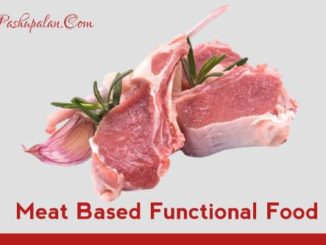
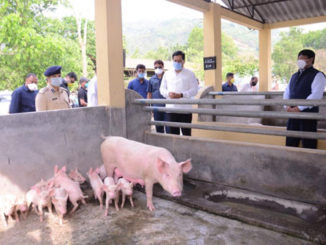


Be the first to comment